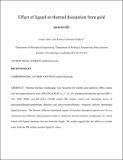Effect of ligand on thermal dissipation from gold nanorods
Author(s)
Alper, Joshua; Hamad-Schifferli, Kimberly
Downloadmain article (767.7Kb)
PUBLISHER_POLICY
Publisher Policy
Article is made available in accordance with the publisher's policy and may be subject to US copyright law. Please refer to the publisher's site for terms of use.
Terms of use
Metadata
Show full item recordAbstract
Thermal interface conductance was measured for soluble gold nanorods (NRs) coated with mercaptocarboxylic acids (HS-(CH[subscript 2])[subscript n]COOH, n = 5, 10, 15), thiolated polyethylene glycols (MW = 356, 1000, 5000), and HS-(CH[subscript2])[subscript 15]-COOH-coated NRs further coated with alternating layers of poly(diallyldimethylammonium chloride) and poly(sodium styrenesulfonate). Ferguson analysis determined ligand thickness. The thermal-diffusion-dominated regime of transient absorption spectra was fit to a continuum heat diffusion finite element model to obtain the thermal interface conductance, G, which varied with ligand chemistry but not molecule length. The results suggest that the ability to exclude water from the NR surface governs ligand G values.
Date issued
2010-02Department
Massachusetts Institute of Technology. Department of Biological Engineering; Massachusetts Institute of Technology. Department of Mechanical EngineeringJournal
Langmuir
Publisher
American Chemical Society
Citation
Alper, Joshua, and Kimberly Hamad-Schifferli. “Effect of Ligands on Thermal Dissipation from Gold Nanorods.” Langmuir 26.6 (2010) : 3786-3789.
Version: Author's final manuscript
ISSN
0743-7463
1520-5827